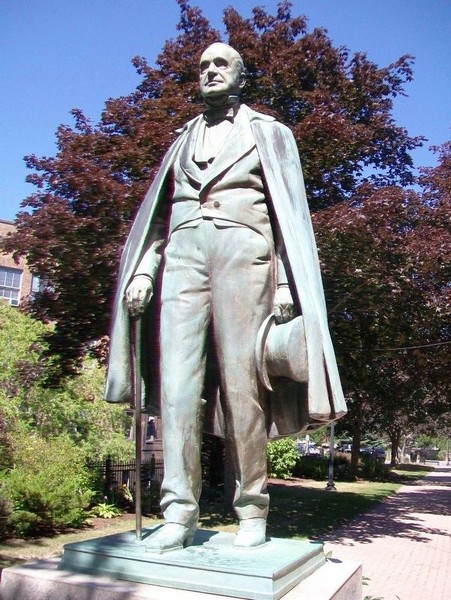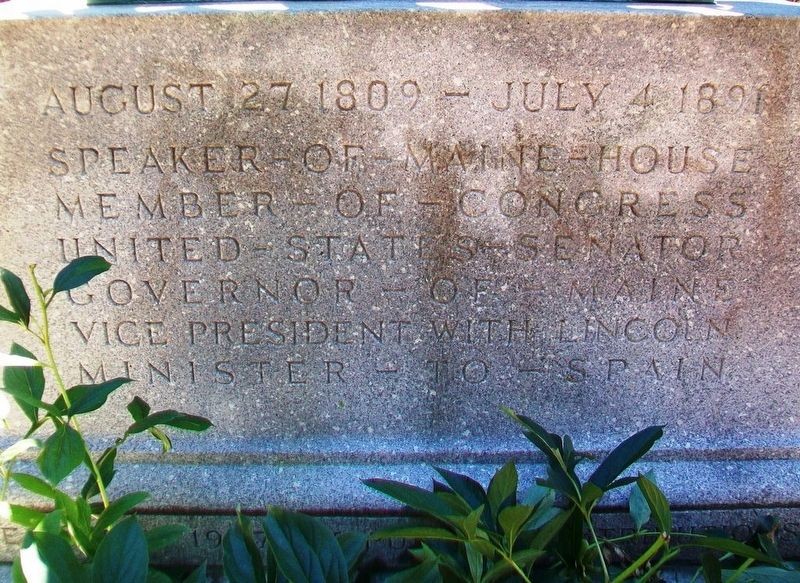Hannibal Hamlin Statue
Introduction
Text-to-speech Audio
Images
Photograph of the Hannibal Hamlin Statue.

Image of Hannibal Hamlin.

Photograph of the Hannibal Hamlin historical marker.

Backstory and Context
Text-to-speech Audio
Hannibal Hamlin (1809-1891) was the 15th Vice President of the United States under President Abraham Lincoln, but his political career did not begin with his vice presidency. Hamlin first attained admission to the Maine bar in 1833 and began a political career two years later when he first served in the Maine House of Representatives from 1836 to 1840 as a Jacksonian Democrat. In 1842, he was elected to the House of Representatives, where he served for five years, and then the Senate in 1848. After he became Senator, he left the Democratic Party in 1856. He took an antislavery position and did not like that the Democratic Party supported the Kansas-Nebraska Act in 1854. He also opposed the Democratic Party's support of slavery. Hamlin was also elected as Maine's first Republican governor in 1856; however, he resigned in 1857 to go back to the Senate.
In 1860, Hamlin was put on the ballot as the Republican Party's vice president candidate with Abraham Lincoln. Hamlin complemented Lincoln well because he was from the Northeast, whereas Lincoln was from Illinois. Hamlin did not want to be nominated for the position, but he decided to follow it through to be loyal to his political party and to the abolition of slavery in the United States. As Vice President, however, Lincoln did not use Hamlin often for support, and Hamlin, for the first time in his political career, was not representing people from Maine. In the 1864 election, Hamlin was not up for re-election and was instead replaced with Southerner Andrew Johnson.
After his term as Vice President, Hamlin was a port collector in Boston and served as president of a railroad company. Despite leaving government for a short time, Hamlin went back and served as a Senator from 1869 to 1881. He then became Minister to Spain in 1881. He returned from Spain in 1882 and returned to his home in Bangor, Maine.
Sources
Fischer, William. Hannibal Hamlin, The Historical Marker Database. November 25th 2017. Accessed January 18th 2020. https://www.hmdb.org/m.asp?m=110584.
Hannibal Hamlin, Britannica . Accessed January 18th 2020. https://www.britannica.com/biography/Hannibal-Hamlin.
Hannibal Hamlin, Architect of the Capitol . Accessed January 18th 2020. https://www.aoc.gov/art/national-statuary-hall-collection/hannibal-hamlin.
Robbins, Ryan R.. Hannibal Hamlin, Bangor in Focus. Accessed January 18th 2020. http://bangorinfo.com/Focus/focus_hannibal_hamlin.html.
Image by William Fischer from the Historical Marker Database.
Image courtesy of Library of Congress.
Image by William Fischer from the Historical Marker Database.
